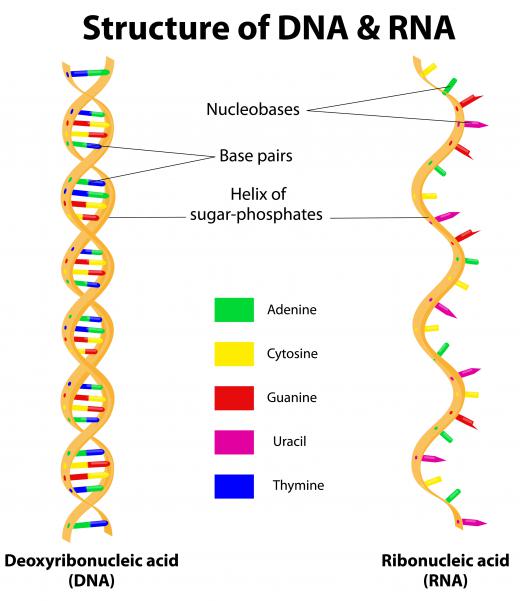What Is a Ribonucleotide?
A ribonucleotide is a precursor to the building blocks of genetic material, called deoxyribonucleic acid (DNA). Ribonucleotides are reduced, meaning to remove oxygen, to deoxyribonucleotides, which are needed to form DNA. Cells use a special enzyme called ribonucleotide reductase during this process. Chains of ribonucleotide molecules are used by cells to form DNA, but single molecules are used in many other cell functions.
Ribonucleotides have exactly one phosphate group, one sugar molecule and one nucleobase. A nucleobase is a nitrogen-containing molecule that is used in cell metabolism. A ribonucleotide contains the same bases used in DNA and has the right amount of phosphate groups to form the backbone of a DNA helix. They are made from similar molecules that have a different number of phosphates groups called ribonucleosides.

Cells use ribonucleosides of many sorts but very limited types of ribonucleotides. Both molecules are used to form other macromolecules, such as ribonucleic acid (RNA). The single molecules are made from ribonucleosides with varying numbers of phosphate groups and the correct base. Although ribonucleotides have only DNA bases, RNA is built with other ribonucleosides as well, as long as the phosphate groups are reduced to only one.
With the proper base, a ribonucleotide becomes useful in other cell functions. These special monomers, or single molecules, are used for cell processes such as regulation. Regulation is how a cell balances energy and activity. Some processes require particular ribonucleotides, especially in DNA formation. The process of creating DNA requires certain bases to line up, and the process becomes controlled by the availability of ribonucleotides.
Other cell functions commonly use a special ribonucleotide called adenine monophosphate. This monomer is used both in RNA and DNA formation as a building block. It can be easily changed into adenine triphosphate, which is the main energy source for cells. The cyclic adenine monophosphate molecule regulates many hormones in humans as well.
The medical uses for ribonucleotides are many. Adenine monophosphate is injected to help with nerve pain. It allows the energy pathways more monomers to use, making nerve cells work better. This monomer is also used to fight shingles, which is a nerve related disease. Many other uses of ribonucleotides have continued to be discovered.
The enzyme ribonucleotide reductase is different for nearly every species. Scientists use this enzyme to study different bacteria and diseases. By limiting the function of the enzyme, the use of ribonucleotides in a target cell is limited as well. This disruption can cause cell death and is sometimes used in developing new techniques for fighting diseases and bacteria growth.
AS FEATURED ON:
AS FEATURED ON:











Discuss this Article
Post your comments